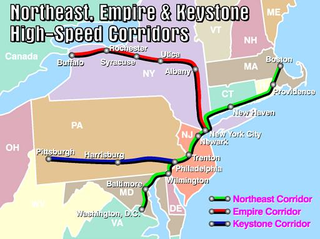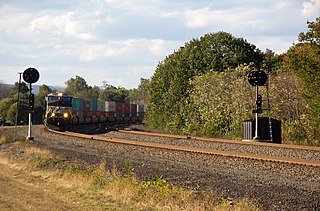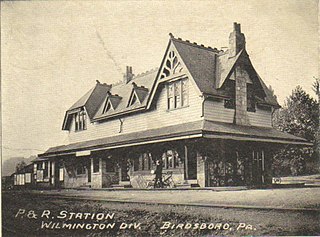Related Research Articles
The Pennsylvania Railroad was an American Class I railroad that was established in 1846 and was headquartered in Philadelphia, Pennsylvania. It was so named because it was established in the Commonwealth of Pennsylvania.

The Northeast Corridor (NEC) is an electrified railroad line in the Northeast megalopolis of the United States. Owned primarily by Amtrak, it runs from Boston through Providence, New Haven, New York City, Philadelphia, Wilmington, and Baltimore to Washington, D.C. The NEC closely parallels Interstate 95 for most of its length, and is the busiest passenger rail line in the United States both by ridership and by service frequency as of 2013. The NEC carries more than 2,200 trains daily.

The Lehigh Line Connection connects Amtrak's Northeast Corridor (NEC) with the Conrail Lehigh Line 2 miles (3.2 km) south of downtown Newark, New Jersey. It leaves the NEC at Hunter Interlocking, and the line is sometimes called the Hunter Connection. Used by New Jersey Transit (NJT) Raritan Valley Line trains since 1997 when it replaced an older connection, it splits from the NEC just north of the former connector, with wider radius curves with a maximum speed of 45 mph, compared to the 15 mph of the original alignment.

The Junction Railroad was a railroad created in 1860 to connect lines west of downtown Philadelphia, Pennsylvania, and allow north-south traffic through the metropolitan area for the first time. The railroad consisted of 3.56 miles of double track and 5.3 miles of sidings. It owned no locomotives or rolling stock. The line connected the Philadelphia and Reading Rail Road line at the west end of the Columbia Bridge over the Schuylkill River, crossed the Pennsylvania Railroad line, ran parallel to Market Street, and turned south to connect with the Philadelphia, Wilmington and Baltimore Railroad at Gray's Ferry.

The Philadelphia, Wilmington and Baltimore Railroad (PW&B) was an American railroad that operated from 1836 to 1881. Formed as a result of the merger of four small lines dating from the earliest days of American railroading in the late 1820s and early 1830s, it was purchased by the Pennsylvania Railroad (PRR) in 1881, becoming part of their main line in 1902.

The Keystone Corridor is a 349-mile (562 km) railroad corridor between Philadelphia and Pittsburgh, Pennsylvania, that consists of two rail lines: Amtrak and SEPTA's Philadelphia-to-Harrisburg main line, which hosts SEPTA's Paoli/Thorndale Line commuter rail service, and Amtrak's Keystone and Pennsylvanian inter-city trains; and the Norfolk Southern Pittsburgh Line. The corridor was originally the Main Line of the Pennsylvania Railroad.

The Delair Bridge is a railroad bridge with a vertical-lift section that crosses the Delaware River between Philadelphia, Pennsylvania, and Pennsauken Township, New Jersey, just south of the Betsy Ross Bridge. The two-track bridge is part of Conrail Shared Assets Operations and is jointly used by Norfolk Southern Railway and CSX Transportation freight trains, as well as by the New Jersey Transit Atlantic City Line service.

The Chesapeake & Delaware Canal Lift Bridge is a railroad bridge with vertical-lift span in the U.S. state of Delaware. It carries a Delmarva Central Railroad rail line across the Chesapeake & Delaware Canal.

The Harrisburg Subdivision is a railroad line owned by CSX Transportation in the U.S. state of Pennsylvania. The line is located in the city of Philadelphia, connecting Greenwich Yard and the Philadelphia Subdivision with the Trenton Subdivision along a former Pennsylvania Railroad line. Much of the Harrisburg Subdivision is the High Line or West Philadelphia Elevated along 31st Street over the 30th Street Station area.

The Schuylkill Branch was a rail line owned and operated by the former Pennsylvania Railroad in the U.S. state of Pennsylvania. The line ran from the Philadelphia to Harrisburg Main Line at 52nd Street in Philadelphia north via Norristown, Reading, and Pottsville to Delano Junction. From Delano Junction, the PRR had trackage rights over the Lehigh Valley Railroad's Hazleton Branch and Tomhicken Branch to Tomhicken, where the PRR's Catawissa Branch began. In conjunction with the Catawissa Branch, Nescopeck Branch, and Wilkes-Barre Branch, the Schuylkill Branch gave the PRR a direct line from Philadelphia to Wilkes-Barre.
The Delaware Extension was a rail line owned and operated by the Pennsylvania Railroad in Philadelphia, Pennsylvania.

The Wilmington Rail Viaduct is a series of fills and bridges, about 4 miles (6.4 km) long, that carries the Northeast Corridor through the city of Wilmington, Delaware, above street level. Constructed between 1902 and 1908, the structure consists principally of fills supported by heavy stone retaining walls, punctuated with plate girder bridges over streets, and augmented by a few sections of brick arch viaduct. Its construction is typical of the Pennsylvania Railroad's architectural practices at the time, and the viaduct has been documented by the Historic American Engineering Record and listed on the National Register of Historic Places. Built by the Pennsylvania Railroad (PRR) as part of a series of grade crossing eliminations along the Northeast Corridor, the elevation of the rail line necessitated several other changes to rail infrastructure in Wilmington, including the construction of the Wilmington Shops at the east end of the viaduct, and the construction of the Wilmington Station and adjacent Pennsylvania Railroad Office Building along the elevated right-of-way.
Union Tower is a closed interlocking tower on the Pennsylvania Railroad's Northeast Corridor in Rahway, New Jersey.
HOOK Tower is a closed interlocking tower on the Pennsylvania Railroad in Marcus Hook, Pennsylvania.

The Atglen and Susquehanna Branch is an abandoned branch line of the Pennsylvania Railroad. The line ran from Lemoyne to Atglen, Pennsylvania.

The Pittsburgh Line is the Norfolk Southern Railway's primary east–west artery in its Pittsburgh Division and Harrisburg Division across the U.S. state of Pennsylvania and is part of the Keystone Corridor, Amtrak-Norfolk Southern's combined rail corridor.

The Trenton Cutoff is a 48-mile (77 km) rail corridor in the U.S. state of Pennsylvania that runs from Morrisville to Glenloch. Today used by Norfolk Southern, it consists of two rail lines: the Morrisville Line, which runs between Morrisville and Ernest, and the Dale Secondary between Ernest and Glenloch.
The New York, Philadelphia and Norfolk Railroad was a railroad line that ran down the spine of the Delmarva Peninsula from Wilmington, Delaware to Cape Charles, Virginia and then by ferry to Norfolk, Virginia. It became part of the Pennsylvania Railroad system.

Birdsboro station can refer to three passenger railway stations in or near Birdsboro, Pennsylvania.
References
- ↑ Norfolk Southern Harrisburg Region Timetable 1, August 4, 2008
- ↑ PRR Eastern Region Electric Power System, Drawing ET-1, dated June 10, 1935 Retrieved November 10, 2010
- 1 2 3 PRR Ward and Bridge interlocking diagrams, dated Jan 1, 1962 Retrieved December 26, 2010.
- ↑ Zeta-Tech presentation Archived 2011-07-28 at the Wayback Machine Retrieved December 26, 2010.
- ↑ NOAA. "Nautical Chart No. 12311: Delaware River, Smyrna River to Wilmington (46th ed., May 2012)". National Oceanic and Atmospheric Administration. Retrieved 26 February 2014.